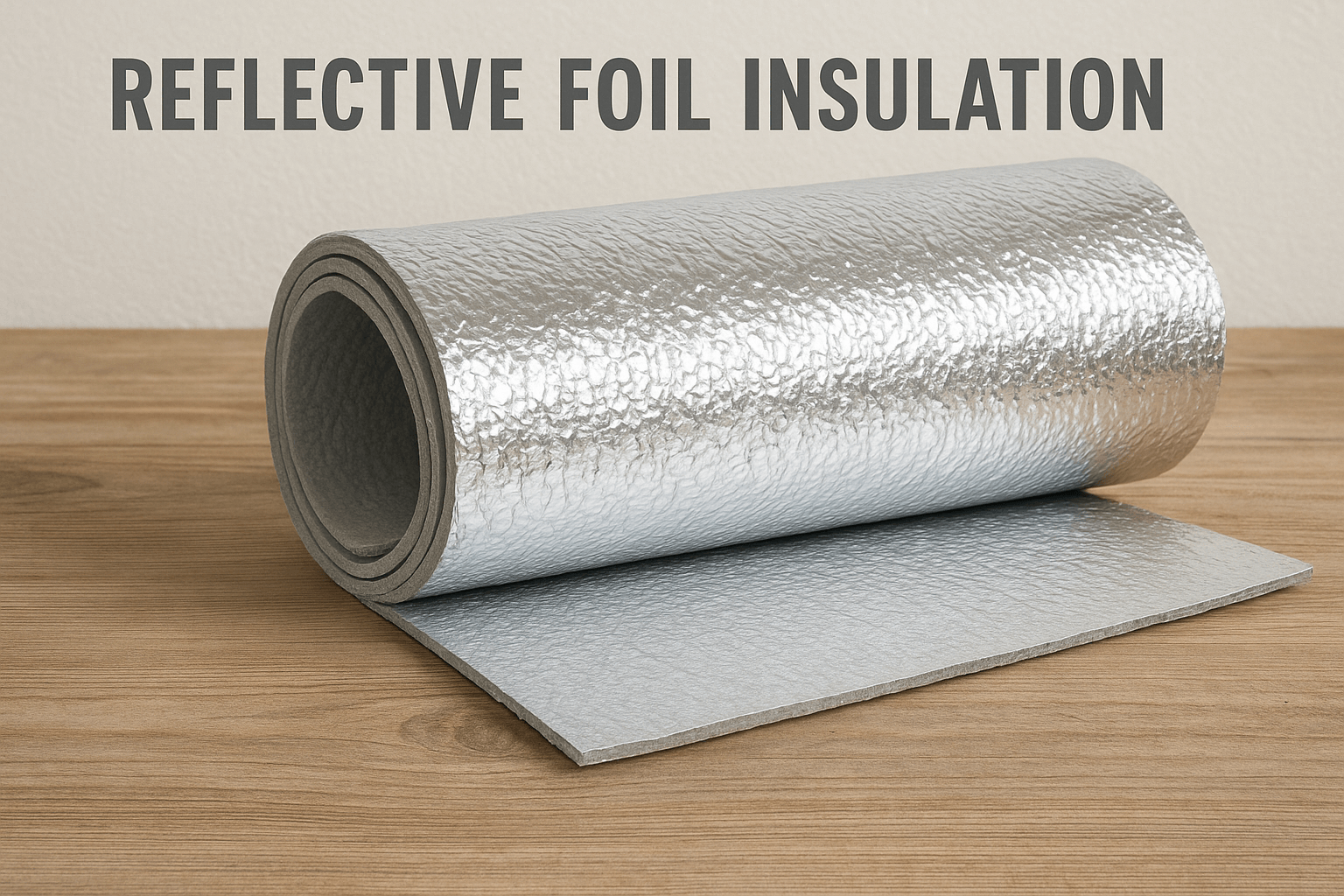What Is Reflective Foil Insulation and How Does It Work?
Many first‑time renovators ask what is reflective foil insulation and whether it really works. This once‑niche radiant‑barrier material has moved into mainstream building and agricultural jobsites because it tackles a specific problem: unchecked summer heat gain and winter radiant losses. Instead of absorbing energy like thick batts, it reflects it—acting as a shiny thermal shield for roofs, walls, and ducts. Trade contractors who buy in bulk from Wellco Wholesale appreciate that they can source pallet quantities of foil‑faced rolls alongside their usual garden, agricultural, and light‑building supplies, keeping procurement simple.

Understanding Reflective Foil Insulation
How Reflective Technology Reduces Heat Transfer
Heat travels by conduction, convection, and radiation. Bulk insulation slows conduction; air‑sealing reins in convection. Foil products focus on radiation: a low‑emissivity (low‑E) aluminum surface bounces up to 97 % of radiant heat away while emitting very little of its own, according to U.S. Department of Energy testing. That surface must face an air gap to do its job, turning the cavity into a thermal mirror rather than a sponge.
Common Materials and Construction Methods
Manufacturers laminate foil to lightweight cores that protect—and help create—that air space: single‑ or double‑bubble polyethylene, woven scrim, or kraft honeycomb. Some rolls are foil on both faces to manage heat flow in either direction; others pair foil with white kraft for a cleaner interior finish. When installed with proper air gaps, assemblies routinely deliver effective R‑values of R‑5 – R‑17, depending on orientation and climate‑zone assumptions.
Quick Comparison to Traditional Bulk Insulation
| Property | Reflective Foil | Fiberglass Batt | Spray Foam | Mineral Wool |
|---|---|---|---|---|
| Primary defense | Radiant | Conductive | Conduction & Air Seal | Conductive |
| Thickness for R‑10* | ≤ 10 mm | 90 mm | 40 mm | 65 mm |
| Weight | Very light | Light | Medium | Heavy |
| Vapor control | Excellent (foil) | Poor | Variable | Good |
*Assembly R‑values vary; figures for illustration only.
Key Benefits for Builders & Property Owners
Energy‑Saving Performance: Data & Statistics
Independent attic studies in hot‑humid U.S. climates show 7 %–15 % cooling‑season energy cuts after adding foil radiant barriers above existing insulation. One Florida school district recorded HVAC runtime savings worth $0.18 per ft² each year, recouping material costs in under three years.
Moisture, Mold, and Allergen Control
Aluminum qualifies as a Class I vapor barrier, limiting moisture migration, curbing mold risk, and discouraging dust‑mite populations—welcome news for anyone with mite allergies. A smooth foil surface also sheds dust that might otherwise harbor allergens.
Lightweight & Easy Handling – Installer Insights
“At 16 ounces for a 4 × 25 ft roll, my crew hauls a whole roof’s worth up a ladder in one trip,” says licensed contractor Maria H., who swapped heavy batts for foil in a desert warehouse retrofit. Labor hours saved funded extra air‑sealing, compounding efficiency gains.
Installation Best Practices
Suitable Applications (Roofs, Walls, Sheds, HVAC)
Foil products shine wherever a reflective surface faces an air space: under rafters, over purlins, behind rain‑screen façades, inside metal barns, and around HVAC ducts. In cold‑dry Zone 6, face the foil inward to reflect heat back; in hot‑humid Zone 2, face it outward to block heat gain.
Step‑by‑Step Installation Checklist
-
Inspect framing for protrusions; repair leaks.
-
Provide at least a ¾‑inch air gap on the reflective side.
-
Unroll & staple foil perpendicular to framing every 8 inches.
-
Seal seams with aluminum tape that matches emissivity.
-
Maintain continuity around penetrations with flexible flashing.
-
Verify ASTM E84 Class A fire rating before covering.
Safety & Compliance Standards to Know
Quality rolls carry an ASTM E84 flame‑spread index under 25 and smoke under 50. Look for ICC‑ES evaluation reports to streamline permit approval.
Real‑World Results & Case Study
Case Study: Agricultural Greenhouse Retrofitted
A mid‑sized vegetable grower in California’s Central Valley lined a 9,000 ft² greenhouse roof with double‑foil bubble rolls sourced through Wellco Wholesale. Midday canopy temperature dropped 5 °C, letting lettuce harvest run two weeks longer into summer. The $4,600 material cost balanced against $2,100 in reduced water use and shading‑screen expenses, hitting breakeven in 26 months.
Quote from Certified Energy Auditor
“Radiant barriers don’t replace mass insulation, but in sun‑soaked structures we’ve measured peak‑load drops of 10 %–12 %,” reports Alex B., CEA, who audited the project.
ROI Timeline and Cost Breakdown
Installed cost ÷ annual savings = payback (years). Greenhouse example: 4,600 ÷ 2,100 ≈ 2.2 years, after which savings are pure margin.
Sourcing & Buying Guide
Choosing the Right Foil Facing & Stated R‑Value
Select double‑bubble for residential attics, woven scrim for barn roofs, or white‑foil composites where finished appearance matters. Demand third‑party R‑value charts based on ASTM C1363 hot‑box tests—never marketing claims alone.
Bulk Purchasing Advantages with Wellco Wholesale
Wellco’s factory‑direct model lets contractors load foil, shade cloth, and drip‑irrigation tape onto the same truck, trimming freight. Bulk tiers start at 10 rolls, with custom lengths available for OEM panelizers and pre‑fab shops.
Sustainability & Certifications to Look For
Choose rolls made from 40 % recycled aluminum, low‑VOC acrylic laminates, and plants certified to ISO 14001. At end‑of‑life, foil layers can be separated and recycled, boosting your project’s ESG scorecard.
Conclusion
Reflective foil insulation reflects radiant heat rather than absorbing it, making buildings cooler in summer and warmer in winter while doubling as a vapor barrier. It installs fast, weighs little, and complements—without replacing—bulk insulation. Contractors buying through Wellco Wholesale can bundle reflective rolls with other site materials and leverage volume pricing. Contact our team today to confirm the right foil spec, request a project quote, and start saving energy on your next build.
Frequently Asked Questions
Q1. Does reflective foil insulation work in cold climates?
Yes. When installed beneath roof sheathing facing the interior, the low‑E surface reflects radiant heat back in, cutting winter losses by 4 %–8 % (Oak Ridge National Laboratory data).
Q2. Can I lay reflective foil directly on top of attic joists?
No. Foil must face an air gap to function. Staple it to the underside of rafters or suspend it above attic insulation instead.
Q3. How do I clean or maintain foil insulation?
Once covered or sealed it needs no maintenance. In exposed sheds, wipe dust with a damp cloth yearly to keep reflectivity high.
Q4. Is it safe around electrical wiring?
Yes. Aluminum is non‑combustible. Just maintain code‑required clearance from high‑temperature fixtures and follow NEC guidelines.
Q5. What roll length should I order for a commercial roof?
Measure linear footage of purlins, add 10 % for overlaps and waste, then consult Wellco Wholesale for custom‑length rolls that minimize seams and labor.

